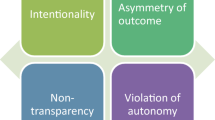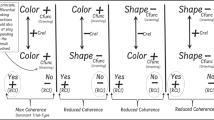Abstract
According to Character Shifting Theory, the rules determining indexical reference vary according to the communication technology used. These rules are established by conventions arising as solutions to coordination problems. I present two objections against Character Shifting Theory. First, I show that individuating context-types according to technologies makes incorrect truth-value predictions. Secondly, such individuation is not possible, as there are no coordination problems that occur when speakers communicate over these technologies. I then consider four ways by which one can respond against my objections and show that none of them succeed. The failure of Character Shifting Theory has implications on the larger debate about whether a fixed-rule intention-insensitive account of indexical reference can be successful.
Similar content being viewed by others
Notes
This is often contrasted with demonstratives, expressions such as ‘that’, ‘this’ or ‘him’, whose reference is considered to be determined by speaker’s directing intentions or an associated physical demonstration or gesture by the speaker.
Since the reference of an indexical varies from one context to another, it can be said that indexical meaning varies from context to context. However, apart from a variant aspect, indexical meaning also has an invariant meaning. For example, although the indexical expression ‘I’ typically refers to the speaker of the utterance ‘I’, the expression also has a context-invariant meaning. Perhaps, the context-invariant meaning coincides with the dictionary meaning of ‘I’ which specifies that it is a pronoun used to refer to oneself. Kaplan’s semantic theory, at least on first glance, successfully captures both these aspects of indexical meaning. The fixed rules governing indexical reference remain fixed across contexts while the reference changes from one context to another.
In this semantic theory, the rules assigned to the indexical expressions determine the reference of ‘I’, ‘here’ and ‘now’ to be the speaker, location of utterance and time of utterance respectively. Further, Kaplan (1989) considers the sentence ‘I am here now’ as a necessary truth because he designates proper contexts as those in which the speaker is present at the time and place of her utterance. From this, it follows that all utterances of ‘I am not here now’ should be necessarily false. This seemingly intuitive prediction that speakers are always present at the time and location of their utterance falls apart when speakers record the sentence ‘I not am here now’ into an answering machines and the recording is played back at a time when the speaker is not present. These utterances are intuitively true, contrary to the prediction Kaplan’s theoretical apparatus makes. This challenge to Kaplan’s theory, following Sidelle (1991), has come to be known as the Answering Machine Paradox.
Another version of such an account, where indexical character is sensitive to particular context-types, is attributed to Corazza et al. (2002). According to this view, the expression ‘here’, for instance, always refers to the location of utterance but what counts as this location is allowed to vary from one context-type to another. Conventions determine what context-type determines indexical reference for what kinds of uses. However, unlike Michaelson (2014), Corazza et al. (2002) fail to give a rule-governed account that specifies what convention is in effect at what kinds of uses.
An example of ambiguity is the expression ‘bat’, which is ambiguous between a flying mammal and a sports equipment (Sennet 2016). Allowing reference of indexicals to vary within a context-type make indexical expressions look ambiguous, which is to say that different utterances of these expressions can have different meanings, an explanation that Michaelson (2014) resists. Michaelson (2014) doesn’t explain in his paper why we should not posit lexical ambiguity, but points to Cohen’s (2013, p.582) demonstration that such a proposal lacks the relevant evidence.
See Lewis (1969) for a more detailed explanation on how conventions solve coordination problems.
This could be a popular desktop chat application like Facebook messenger or even a popular application on mobile phones such as WhatsApp or even the regular text message application on mobile phones. My counterexamples succeed over all kinds of such virtual applications because on these, the expression ‘here’ can refer to either the presence of the speaker over the application or the speaker’s physical presence.
The reference of ‘here’ is similarly ambiguous on other kinds of virtual applications, such as online or video games. Imagine two players, from different geographical locations, plugged into an online game where each assumes a virtual avatar. Further imagine, that the game involves these avatars moving from one location to another, within the game universe. With this as the setup, if the players had means to communicate with each other while playing the game, one can imagine that they can the word ‘here’ to refer to either the location within the game universe, or to the physical location at which they’re playing the game.
With regard to these diverse uses of indexical expressions, Michaelson (2014) prefers a pragmatic explanation to account for their reference. This is because, according to Michaelson (2014) there is no observed regularity in the reference of these expressions, when used in these diverse ways, that a semantic rule can consistently capture in its predictions. The contextual cues that govern departures from Kaplanian referents in these cases are far too complex, for a convention-based account to predict systematically. As I show in my counterexamples, a similar problem can be seen in departures from Kaplanian theory within straightforward indexical uses over a single communication technology. A single-rule can account for the departures in reference occuring in my counterexamples, and therefore cannot give us correct predictions.
Here is a standard example of bound variable use:
(7) Every boy in the school thinks he will pass the exam.
In (7) ‘he’ is a variable that is bound to the quantifying phrase ‘every boy’ which fixes its reference, instead of the context of utterance.
While looking at shifts in reference, we can proceed without considering the scope or extent of the referent. For instance, in the sentences ‘It is cold here’ and ‘I feel dizzy now’, ‘here’ and ‘now’ seem to pick out the place and time of the utterance respectively. The referents, however, seem to include more than just the immediate place and time of the utterance. Referents of ‘here’ and ‘now’ usually lack clearly defined boundaries in the actual world. Indexical uses of ‘here’ can pick out the place where one is standing, the city where one resides or even the entire country. Similarly, ‘now’ can pick out the very instance of utterance, the day or an entire era. For our purpose, we can proceed without considering such shifts in the scope of indexical referents because, while looking at judgements of competent speakers towards indexical reference, we only concern with what is semantically mandated, by the purported rule, to fix the content of the expression - the referent. In (4), for instance, ‘now’ refers to the time of the reading or tokening. The lack of clearly defined boundary with respect to how long this time extends before or after the time of reading, does not influence judgements on whether ‘now’ refers to the time of reading or the time of inscription.
Michaelson (2014) himself considers this response, using the example of a recorded video will that is being played to the family members of the deceased person beginning with the following utterances:
(8) Today I met with my lawyer to go over all the details before making this video.
(9) Today you all received a phone call telling you to come to my lawyer’s office.
The indexical ‘today’ in (8) refers to the day of recording and in (9) refers to the day of playback. Michaelson (2014) considers video will to be a new type device and therefore a prospective context-type. To him, this example is evidence ‘that a singular convention for using ‘today’ on video wills has yet to emerge’ (527). Eventually, he predicts, one of the ways of referring becomes dominant over video wills, a context-type is individuated with a fixed reference rule. However, individuation context-types occurs when conventions are established in response to coordination problems which arise while speakers learn to use a new recording technology. In his own example, Michaelson (2014) provides no coordination problem, with respect to which a convention would develop.
This would be similar to the view proposed by Stevens (2009), that answering machine utterances need not be seen as semantic data even though they are well-formed tokens of language.
References
Cohen, J. (2013). Indexicality and the puzzle of the answering machine. Journal of Philosophy, 110(1), 5–32.
Corazza, E., Fish, W., & Gorvett, J. (2002). Who is I? Philosophical Studies, 107, 1–21.
Kaplan, D. 1989. Demonstratives: An essay on the semantics, logic, metaphysics, and epistemology of demonstratives and other indexicals. In J. Almog, J. Perry, and H. Wettstein, editors, Themes From Kaplan, chapter 17, pages 481–463. Oxford University Press, New York. Originally circulated as a mimeograph from the Department of Philosophy, UCLA.
Lewis, D. (1969). Convention. Cambridge: Harvard University Press.
Michaelson, E. (2014). Shifty characters. Philosophical Studies, 167(3), 519–540.
Predelli, S. (2005). Contexts: Meaning, Truth, and the Use of Language. Clarendon Press.
Sennet, A. (2016). ‘Ambiguity’, The Stanford Encyclopedia of Philosophy (Spring 2016 Edition). In E. N. Zalta (Ed.), URL = <https://plato.stanford.edu/archives/spr2016/entries/ambiguity/> (visited on 19/03/2019).
Sidelle, A. (1991). The answering machine paradox. Canadian Journal of Philosophy, 21, 525–539.
Stevens, G. (2009). Utterance at a distance. Philosophical Studies, 143(2), 213–221.
Acknowledgments
I would like to express my sincere gratitude to my supervisor Alexander Stewart Davies for his unwavering support, encouragement and patience throughout this project.
Author information
Authors and Affiliations
Corresponding author
Additional information
Publisher’s Note
Springer Nature remains neutral with regard to jurisdictional claims in published maps and institutional affiliations.
Rights and permissions
About this article
Cite this article
Gidwani, T. Indexicals and Character Shifting. Philosophia 47, 1475–1486 (2019). https://doi.org/10.1007/s11406-019-00070-y
Received:
Revised:
Accepted:
Published:
Issue Date:
DOI: https://doi.org/10.1007/s11406-019-00070-y




